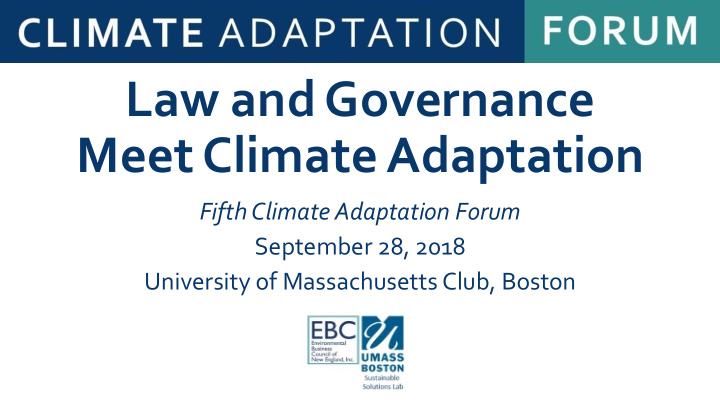



Law and Governance Meet Climate Adaptation Fifth Climate Adaptation Forum September 28, 2018 University of Massachusetts Club, Boston
Resilient Cambridge Iram Farooq AICP, LEED-AP Assistant City Manager for Community Development City of Cambridge, Massachusetts Sustainable Quarterly Climate Adaptation Forum | September 28, 2018 Solutions Lab
Resilient Cambridge Legal & Governance Challenges Iram Farooq Assistant City Manager for Community Development Climate Adaptation Forum September 28, 2018
Cambridge Climate Change Risks Heat Vulnerability Urban Street & Riverine Flooding Emerging Storm Surge Flooding with Sea Level Rise
Flooding Stress Test Heat Stress Test
Resilie ience Str trategie ies A Prepared Community : Strategies to strengthen community, social, and economic resilience. B Adapted Buildings: Strategies to protect buildings against projected climate change impacts. C Resilient Infrastructure: Strategies to ensure continued service or a speedy recovery from community- wide infrastructure systems. D Resilient ecosystems: An enhanced living 6 environment integrating air quality, waterways, green infrastructure, and the urban forest as a system resilient to climate impacts.
Integrating Planning Initiatives 7
Challenge: Moving Targets Design Flood Elevations Move Up and/or Down Due to Climate Change 1971-2000 Changing Data • Shifting rates of design storms • Improved topographic data • Hydrologic model refinements
Challenge: Moving Targets Design Flood Elevations Move Up and/or Down Due to Uncertainty Boston Harbor Flood Risk Model Assumes 3.4 feet of Sea Level Rise by 2070 6.6 ft 3.9 ft 1.6 ft 0.7 ft 2012 National Climate Assessment SLR Rates Based on GHG Emission Scenarios 2070 SLR/Storm Surge Flood Risk
Challenge: Moving Targets Design Elevations Move Up and/or Down Due to Emerging & Unquantified Risks Joint Probabilities of Storm Surge & Catastrophic Precipitation Heavy Precipitation Hurricane Florence, North Carolina 2018
Challenge: Moving Targets Cambridge FloodViewer – Accessible Flood Extent & Elevation Data Cambridge Design Flood Elevation Guidance • Build/protect to 2070 10% annual risk • Recover from 2070 1% annual risk
Challenge: Urban Design with Adaptation Learning to Live With Water July 10, 2010
Raised Plinth Envision Cambridge envision.cambridgema.gov
Coordinating Building and Street Design
State Building Code – State Pre-emption Cambridge Highlands Project – Homeowner’s Rehab, Inc. Resiliency Features • 98 affordable units • Passive House level performance • Expect indoor temps can stay within 55- 85˚ F for 4 days passively • Solar PV • All units above 2070 flood • Mechanicals on roof • Community room on top floor Except for elevation requirements, the City cannot require any of the other resiliency features
Sea Level Rise/Storm Surge Risk is a Regional Problem AED Schafft Site CRD Source: Kleinfelder & Woods Hole Group for the City of Cambridge, February 2017 based on Boston Harbor Flood Risk Model, MassDOT
Regional Flood Risk Mitigation Planning Amelia Earhart Dam (Source: MaUSHarbors.com)
Climate Ready Boston: Schrafft’s Center Schrafft’s Waterfront Park – Storm Surge Barrier Center Benefit to Charlestown, Somerville, and Cambridge
Challenge: Dependence on Regional Infrastructure MBTA Alewife Station & Red Line – Increasing Flood Risk in Cambridge FEMA Flood Zone 2030 100-Year Flood 2070 SLR/Storm Surge
MBTA Red Line Vulnerable to Flooding in Boston 2050 1% Annual Flood Risk
Contact Iram Farooq Assistant City Manager for Community Development Community Development Department ifarooq@cambridgema.gov John Bolduc Environmental Planner Community Development Department jbolduc@cambridgema.gov
Recommend
More recommend